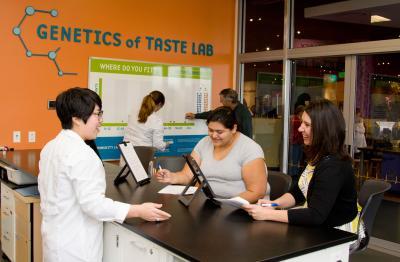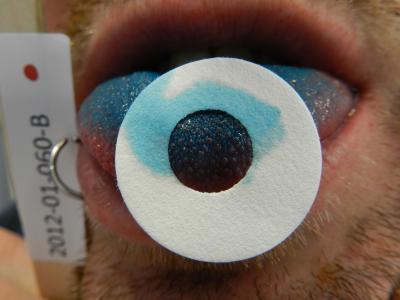Can you predict how sensitive your sense of taste is by sticking your tongue out and counting the bumps?
A long-standing hypothesis says this is so. But a little crowdsourcing of science - what used to be called doing a study - disproved that idea that "supertasters" owe their special sensitivity to bitter tastes to an usually high density of taste buds on their tongue, according to a paper in Frontiers in Integrative Neuroscience.
Supertasters are people who can detect and are extremely sensitive to phenylthiocarbamide and propylthiouracil, two compounds related to the bitter molecules in certain foods such as broccoli and kale. Supertasting has been used to explain why some people don't like spicy foods or "hoppy" beers, or why some kids are picky eaters.

Close-up of the fungiform papillae on the tongue of a Museum guest enrolling in the Genetics of Taste Lab to be analyzed using Denver Papillae Protocol. Credit: Denver Museum of Nature&Science.
The sensitivity to these bitter tastants is partly due to a variation in the taste receptor gene TAS2R38. But some scientists believe that the ability to supertaste is also boosted by a greater-than-average number of "papillae", bumps on the tongue that contain taste buds. Nicole Garneau, Curator and Chair of the Department of Health Sciences, Denver Museum of Nature & Science, and colleagues tested if this is true.
Over 3,000 visitors to the museum's Genetics of Taste Lab volunteered to stick their tongue out so that their papillae could be counted and their sensitivity to phenylthiocarbamide and propylthiouracil measured. In total, 394 study subjects were included in the analysis. Cell swabs from volunteers were taken to determine their DNA sequence at TAS2R38. Results confirmed that certain variations in TAS2R38 make it more likely that somebody is sensitive to bitter, but also proved that the number of papillae on the tongue does not affect increased taste sensitivity.

Citizen scientists in the Genetics of Taste Lab enroll Museum guests in the research study. Guests answer questions about themselves and mark their age and gender on the Where Do You Fit data tracking wall. The lab is located as a specialized learning area of Expedition Health, the Museum's permanent health exhibition shown in the background. Credit: Denver Museum of Nature & Science.
"No matter how we looked at the data, we couldn't replicate this long held assumption that a high number of papillae equals supertasting," says Garneau.
The authors argue against the continued misuse of the term supertaster, and for the use of the more objective term hypergeusia – abnormally sensitized taste – to describe people who are sensitive to all tastes and sensations from food.
"What we know and understand about how our bodies work improves greatly when we challenge central dogmas of our knowledge. This is the nature of science itself," adds Garneau. "As techniques improve, so too does our ability to do science, and we find that what we accepted as truth 20, 30, or 100 years ago gets replaced with better theories as we gather new data, which advances science. In this case, we've proven that with the 'Denver Papillae Protocol', our new method for objective analysis for papillae density, we were unable to replicate well-known studies about supertasting."
What make this study unique is that most of the results were collected by citizen scientists including over 130 volunteers who had been specially trained by Garneau and her colleagues. The Genetics of Taste Lab is located in the heart of the museum, uniquely situated to attract volunteers and dedicated citizen scientists who conduct population-based research about human genetics, taste, and health.





Comments